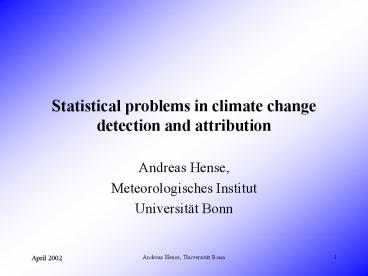Statistical problems in climate change detection and attribution - PowerPoint PPT Presentation
1 / 24
Title:
Statistical problems in climate change detection and attribution
Description:
Null Hypothesis H0 : Random Natural Variability. Alternative Hypothesis HA : No ... joint work with Seung-Ki Min, Heiko Paeth and Won-Tae Kwon. April 2002 ... – PowerPoint PPT presentation
Number of Views:19
Avg rating:3.0/5.0
Title: Statistical problems in climate change detection and attribution
1
Statistical problems in climate change detection
and attribution
- Andreas Hense,
- Meteorologisches Institut
- Universität Bonn
2
Overview
- Introduction
- The detection problem
- The attribution problem
- The Bayesian view
- Summary and Conclusion
3
Yes or No ?
Random Variations?
Detection
4
Yes or No ?
Attribution
5
The detection problem
Null Hypothesis H0 Random Natural Variability
Alternative Hypothesis HA No natural Variability
... and a testvariable to measure the climate
change
6
Probability for testvariable in case of H0 lt
0.05 ... 0.01
Rejection of H0
7
The testvariable
- Collect the information from field data
- Collect natural variability information
- multivariate statistics
- data vector d
- covariance matrix S
- optimize change analysis
- optimal fingerprint
- fingerprint vector g
8
The testvariable
- Data and fingerprint are Gaussian variables
- data fingerprint if distance d - g small
- Mahalanobis distance D² natural measure
9
Amplitude of modeled change
Amplitude of observed change
Hasselmanns optimal fingerprint similarity
measure
10
(No Transcript)
11
A detection experiment (Paeth and Hense, 2001)
Observation time
Simulation time
12
The attribution problem
- Assumption for detection
- climate change g is constant
- no variability in climate change scenario
- Assume a climate change ensemble
- defines an Alternative - Hypothesis HA
- Only possible by climate modelling
13
The attribution problem
Random climate variations Control run
Null Hypothesis ensemble
H0
Climate Change Greenhouse gase scenario
Alternative Hypothesis ensemble
HA
14
The misclassification
Reality
OK
Decision
OK
15
The attribution problem
- Optimal classification
- Minimize the cost of misclassification
- Bayes-Decision
- Classical discrimination analysis
16
The Attribution problem
- Bayes Decision with least costs is given if
- observation part of Control
if prob(obs control) gt prob(obs
scenario) - observation part of scenario
if prob(obs control) lt prob(obs
scenario)
17
The attribution problem
18
The Bayesian View
- Sir Thomas Bayes 1763
- allows you to start with what you already believe
(in climate change) - to see how new information changes your
confidence in that belief
19
The Bayesian view
Less weight
More weight
The Climate Sceptics
Equal weight
Equal weight
The Uninformed
Less weight
More weight
The Environmentalist
20
A Bayesian attribution experiment
- ECHAM3/LSG 1880-1979 Control
- ECHAM3/LSG in 2000 Scenario
- NCEP Reanalysis Data 1958-1999 Observations
- Northern hemisphere area averages
- near surface (2m) Temperature
- 70 hPa Temperature
- joint work with Seung-Ki Min, Heiko Paeth and
Won-Tae Kwon
21
A Bayesian Attribution experiment
The Uninformed
22
A Bayesian attribution experiment
The Environmentalist
The Climate Sceptics
23
Summary and Conclusion
- Climate change detection and attribution are
classical statistical prodecures - detection Mahalanobis distance
- attribution discriminant analysis
- attribution internal variability in climate
change scenario through ensemble simulations - Bayesian statistics unified view
24
Summary and Conclusion
- Application to ECHAM3/LSG Ensemble and NCEP
Reanalysis data - Northern Hemisphere area averaged temperatures
(2m and 70 hPa) - 1995-1999 increasing classification into
ECHAM3/LSG in model year 2000 - weak evidence and 10 to 15 misclassification
risk - Missing processes in climate change simulation?































